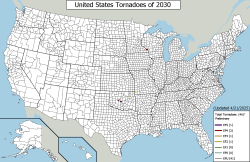Tornadoes of 2030
 A map of 2030 United States tornado paths from the results of preliminary surveys. | |
| Timespan | January 1 – ongoing |
| Maximum rated tornado |
EF5 tornado Moore, Oklahoma on May 11
|
| Tornadoes in U.S. |
47 |
| Damage (U.S.) | ≥$3.7 billion (2030 USD) |
| Fatalities (U.S.) | 68 |
| Fatalities (worldwide) |
68 |
|
| |
| 2028 • 2029 • 2030 • 2031 • 2032 | |
This page documents notable tornadoes and tornado outbreaks worldwide in 2030. Strong and destructive tornadoes form most frequently in the United States, Argentina, Southern Brazil, the Bengal region and China, but can occur almost anywhere under the right conditions. Tornadoes also develop occasionally in southern Canada during summer in the Northern Hemisphere and somewhat regularly at other times of the year across Europe, South Africa, Japan, Australia and New Zealand. Tornadic events are often accompanied by other forms of severe weather, including thunderstorms, strong winds and hail.
Worldwide, 67 tornado-related deaths were confirmed – 67 in the United States.
Events
United States
| EFU | EF0 | EF1 | EF2 | EF3 | EF4 | EF5 | Total |
|---|---|---|---|---|---|---|---|
| 2 | 20 | 13 | 7 | 2 | 2 | 1 | 47 |
- Note: Two tornadoes has been officially confirmed but are yet to receive a rating.
January
February
March
March 3 (United States)
| EFU | EF0 | EF1 | EF2 | EF3 | EF4 | EF5 |
|---|---|---|---|---|---|---|
| 0 | 0 | 0 | 0 | 0 | 0 | 0 |
TBD
April
May
May 11-12 (United States)
| EFU | EF0 | EF1 | EF2 | EF3 | EF4 | EF5 |
|---|---|---|---|---|---|---|
| 0 | 8 | 4 | 3 | 2 | 1 | 1 |
The tornado outbreak of May 11–12, 2030, stands as one of the most destructive severe weather events in recent U.S. history, particularly impacting Oklahoma, Kansas, and Missouri. Over a span of approximately 14 hours, 19 tornadoes were confirmed, including an EF5 in Moore, Oklahoma, and an EF4 in El Reno. The outbreak resulted in at least 61 fatalities and over 462 injuries, with the Moore tornado alone accounting for 39 deaths and 324 injuries. Total damages from the outbreak were estimated at approximately $3.7 billion (2030 USD), making it one of the costliest May outbreaks on record.
The outbreak was triggered by a potent springtime low-pressure system interacting with a moist and unstable air mass over the central United States. The Storm Prediction Center issued a Moderate Risk for severe weather on May 11, highlighting the potential for long-track, violent tornadoes. Supercell thunderstorms developed rapidly during the afternoon hours, particularly near the dryline–warm front triple point in central Oklahoma. While most tornadoes were weak to moderate in intensity, the EF5 tornado in Moore and the EF4 in El Reno caused catastrophic damage.
In addition to the Moore and El Reno tornadoes, significant tornadoes impacted Stillwater, Ponca City, Tulsa, and Loma Linda, Missouri. The Tulsa EF3 tornado, which struck during the early morning hours of May 12, caused four fatalities and injured 34 people. The Loma Linda EF2 tornado resulted in one fatality and 12 injuries. Emergency declarations were issued across the affected states, and recovery efforts continued for weeks. The outbreak underscored the vulnerability of the Southern Plains to severe weather and prompted renewed discussions on tornado preparedness and building resilience.
May 25 (United States)
| EFU | EF0 | EF1 | EF2 | EF3 | EF4 | EF5 |
|---|---|---|---|---|---|---|
| 2 | 12 | 9 | 4 | 0 | 1 | 0 |
Currently an ongoing severe weather event.
